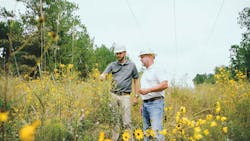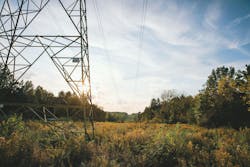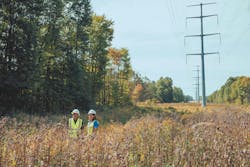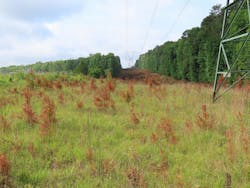Selling IVM to the C-Suite
One of the most critical factors in the success of an integrated vegetation management (IVM) program is support from managers and executive leadership. Gaining that buy-in, however, can be a challenge. While leaders may be nominally familiar with IVM, they likely have limited knowledge of the economic, environmental, and operational advantages of a well-executed IVM strategy. Further, what knowledge they do have about IVM may be influenced by well-intentioned but inaccurate public sentiment, or by their own biases against herbicide use.
As a result, vegetation managers can be effectively limited to a ‘business as usual’ approach exclusively using mowing or other mechanical controls. But managers keen to implement IVM can make a persuasive argument using credible, industry-supported data on the environmental, operational, and fiscal advantages an IVM program can offer, along with simple but effective presentation tactics.
We hope this information will help guide conversations with, or presentations to, your executives and other senior leaders, and we would encourage anyone leading those presentations to consider a ‘flow’ similar to what we’ve laid out below: an overview of what IVM is and isn’t, how it works, and why utilities might consider adopting IVM as a practice.
The ‘What’
The ‘How’
While experienced vegetation managers are likely familiar with the intricacies of IVM, it’s worth remembering that the audience for an IVM sales pitch may not have that same level of familiarity. Be ready to draw from your own experience and research, as well as anecdotal evidence from colleagues in the industry and supporting information like that below, as you prepare an overview that’s appropriate for the knowledge level of your audience
From a strict program efficacy standpoint, IVM contributes to improved vegetation control in several key ways. First, mowing cuts down everything, creating near bare-ground conditions that are perfect for the emergence of undesirable trees and shrubs. However, the use of selective herbicides and application methods within an IVM framework allows native ground covers and other desirable vegetation to flourish; when these species are allowed to grow, they effectively ‘crowd out’ incompatible trees and shrubs, and over time will help reduce overall stem density.
Second, mowing leaves root systems intact, meaning undesirable trees and shrubs can regrow. Using IVM best practices, these stems are typically treated using appropriate selective herbicides, along with selective or individual plant treatment methods such as dormant-stem, low volume foliar backpack or basal-bark applications. Assuming the treatment was made properly, regrowth becomes virtually a non-issue.
A well-planned, well-executed IVM program returns more than just improved control, however. As native grasses and ground covers become established and out-compete woody brush species, fewer inputs are required for control, meaning overall vegetation management costs decrease. And as stem density decreases, treatment cycle lengths increase, further reducing long-term VM expenses.
But these are just the most visible benefits of an IVM program, the ones we can point to in the field or on a spreadsheet. It’s the less-tangible aspects of IVM that may ultimately hold the greatest value
The ‘Why’
In recent years, wildfires, grid failures, and burning coal have become all-too-common answers to the question, “What’s your first thought when you think about your utility provider?” It’s safe to presume, therefore, that utilities are more concerned today than in years past with public perception of the utility as a member of the community. And while no single action or program can be expected to completely reverse public opinion, an IVM program gives the utility a unique opportunity to promote the positive environmental impacts and sound fiscal stewardship associated with IVM.
Consider:
Herbicide applications associated with an IVM program release less carbon into the atmosphere than mowing. According to research conducted by Asplundh Tree Expert, mechanical mowing releases 8 times more carbon – an average of over 175 pounds per acre mowed – than high-volume foliar herbicide applications, while selective low-volume basal and foliar applications required virtually no fossil fuels whatsoever.
IVM helps create habitat, while mowing damages it. According to a 70-year research study of the effects of ROW vegetation management practices on wildlife habitat conducted by Penn State university at State Game Lands 33 (SGL33) in Pennsylvania, IVM practices yield a greater number and richness of breeding bird populations, while still reducing undesirable stem counts within wire and border zones. The SGL33 study also finds lower bee populations on mowed plots as compared with IVM-treated plots.
IVM demonstrates a commitment to sustainable operations. For utilities eager to protect (or repair) their images as members of the communities they serve, a successful IVM program offers the chance to promote the utility’s efforts toward carbon reduction, pollinator protection, habitat restoration and preservation, and fiscal responsibility.
IVM produces less fuel for wildfire. A well-executed IVM program eliminates many of the tallest and most flammable plant species while allowing low-growing grasses and other vegetation to form a natural firebreak. Mowing, however, can stimulate the regrowth of woody shrubs and trees, can spread viable seeds, and as a result can create a greater fire risk over time.
IVM looks better. Nobody likes to look at ‘scalped’ ROWs, but that’s exactly what happens under a mowing-only vegetation management program. The use of selective herbicides as part of an IVM program, however, preserves native ground covers and vegetation, reducing the unsightly effects of mowing. In addition, applications associated with an IVM program can be made during the winter, reducing the risk of herbicide ‘brown-out.’ When selective herbicides are combined with a selective application method, brown-out risk is even lower.
And because it’s worth repeating:
IVM costs less long-term. According to “The Cost Efficiency of IVM,” a meta-analysis prepared by industry expert John W. Goodfellow, IVM programs have consistently demonstrated cost savings of between 25% and 57% as compared to programs using mechanical mowing exclusively. Goodfellow’s figures are based on a 20-year present-value cost prediction, using three- to six-year treatment cycles.The Pitch
If you get the opportunity to ‘pitch’ IVM to executives or upper management, congratulations! Take a deep breath, understand and accept that you’ll be the expert in the room, and take the time to prepare a presentation that lays out the case for IVM in a logical, easy-to-follow progression. Other thoughts to keep in mind:
Don’t assume your audience is familiar with IVM. If possible, find out before your meeting what your audience knows about IVM and tailor your presentation accordingly. If you’re speaking to operations managers, for example, they may not need to have IVM explained to them in detail.
Keep it simple, keep it brief. If you have a half-hour for your meeting, make sure your presentation takes no more than 10-15 minutes so you have plenty of time to answer questions. Don’t overload your audience with technical details; if this is an initial pitch meant to introduce the idea of IVM, there will be plenty of time (and more appropriate audiences) for technical discussions.
Tailor your presentation to the job function(s) of your audience. If you’re speaking to financial leaders, be sure to emphasize the cost savings associated with IVM. Likewise, if you’re presenting to ESG or corporate responsibility officers, highlight IVM’s environmental benefits.
Practice your presentation. Skilled speakers make their presentations seem easy and effortless; that’s the look you’re going for. Take the time to write out the points you want to make, in the order you want to make them. Practice your presentation from start to finish, but try to avoid writing it down and reciting it word-for-word. If you’re using a presentation app such as Microsoft® PowerPoint® or Apple Keynote®, prepare the deck well in advance. Make sure any embedded videos play seamlessly, and familiarize yourself with the technology available in the conference space you’ll be using; nothing saps an audience’s attention faster than a presenter struggling to connect with monitors or other devices.
Don’t over- or under-promise. Like any other practice or system, IVM isn’t a fix for every budgetary or operational problem. It’s a proven-effective vegetation management practice that can reduce VM expenses while also reducing the environmental impact of your overall VM program. Set reasonable expectations about what IVM (and you and your team) can accomplish.
Be ready for questions or objections. Both are natural components of the sales process, which is ultimately what you’re doing…selling IVM as a practice. Try to anticipate the questions you’re likely to receive from your specific audience. Will they have technical or operational questions? Will they want more information, or supporting research or documentation? Will they question the increased use of herbicides? Being ready with quick, comprehensive answers to these and other likely questions will help you gain the confidence of your audience.
Show what adoption looks like. With numbers. Be prepared to talk about what adoption of IVM might involve, based on your specific utility’s current VM program. Be ready to answer questions about labor requirements (which will likely be lower), necessary equipment (which you may already have), and budgetary requirements (possibly higher in the short term, but dropping over the course of the treatment cycle). Here’s where your chemical sales representative can be a huge help; reach out to them sooner rather than later so your rep has time to assess your current efforts and the various requirements of an IVM program.
Ultimately, ROW vegetation must be managed. That management can be performed in either a high-impact manner such as mechanical mowing, or a lower-impact manner like IVM. The agronomic, economic, and environmental advantages of IVM are well documented and accepted by the industry, and the supporting research is peer-reviewed and virtually indisputable. And while it may not be appropriate for every utility or every acre of right-of-way, for those who can and do adopt it, IVM has a proven ability to turn a vegetation management program from a financial liability to an environmental, fiscal, and reputational asset.Darrell Russell is a market development specialist with Corteva Agriscience, with over 25 years’ experience in vegetation management. Darrell holds a BS in Electrical, Electronics and Communications Engineering from the University of Dayton, as well as an MBA from Washington University in St. Louis.
Lucas Madison is a territory manager and vegetation management specialist with Corteva Agriscience. Lucas earned his BS in Fisheries and Wildlife Biology from Arkansas Tech University, and is an ISA-certified arborist, utility specialist, and Oak Wilt Qualified.
About the Author
Lucas Madison
Lucas Madison ([email protected]) is a vegetation management specialist with Corteva Agriscience. Madison uses more than 13 years of experience with forestry and agricultural solutions to provide technical support, product recommendations and industry best practices to vegetation management customers throughout Arkansas, Missouri and Oklahoma. He is based in northern Arkansas.
Darrell Russell
Darrell Russell is a market development specialist with Corteva Agriscience, with over 25 years’ experience in vegetation management. Darrell holds a BS in Electrical, Electronics and Communications Engineering from the University of Dayton, as well as an MBA from Washington University in St. Louis.





